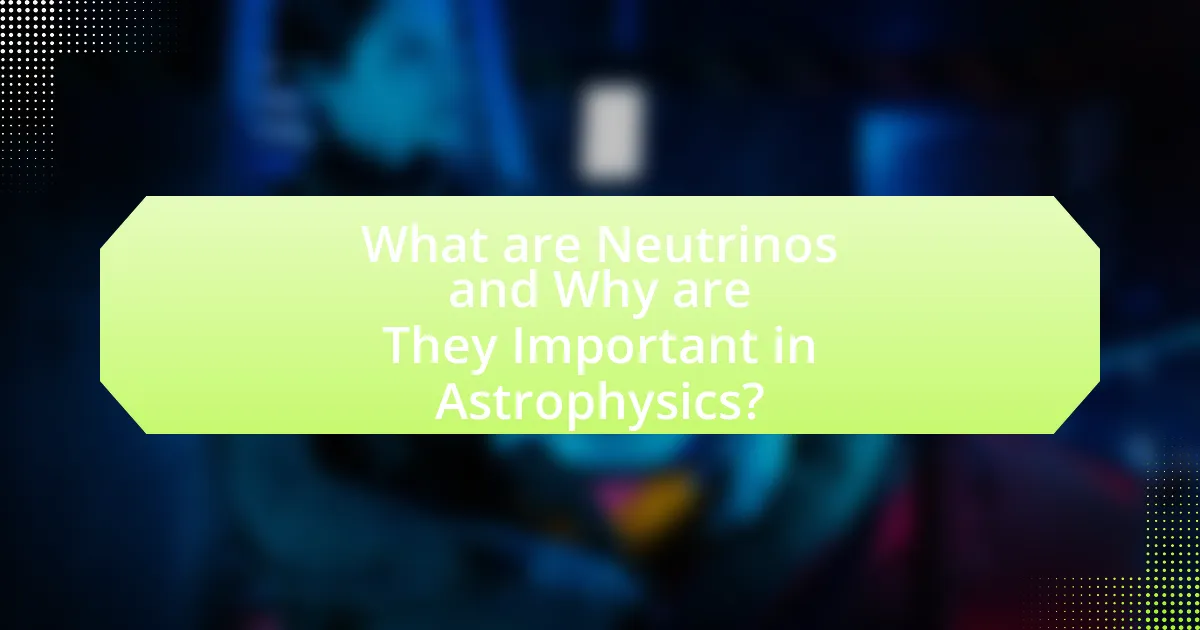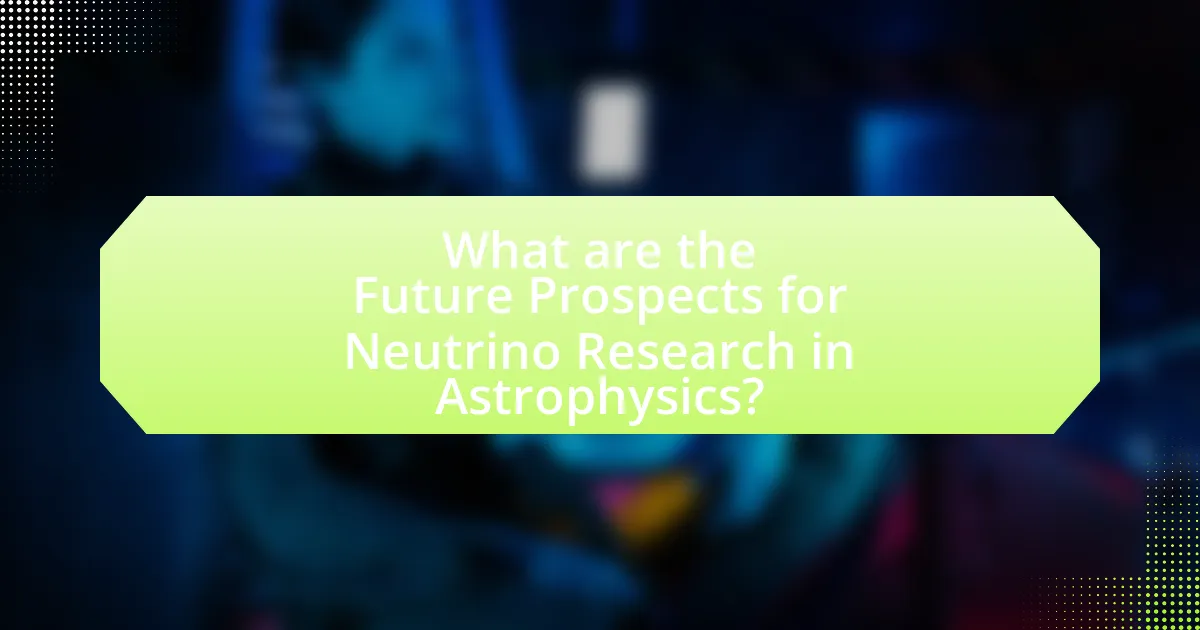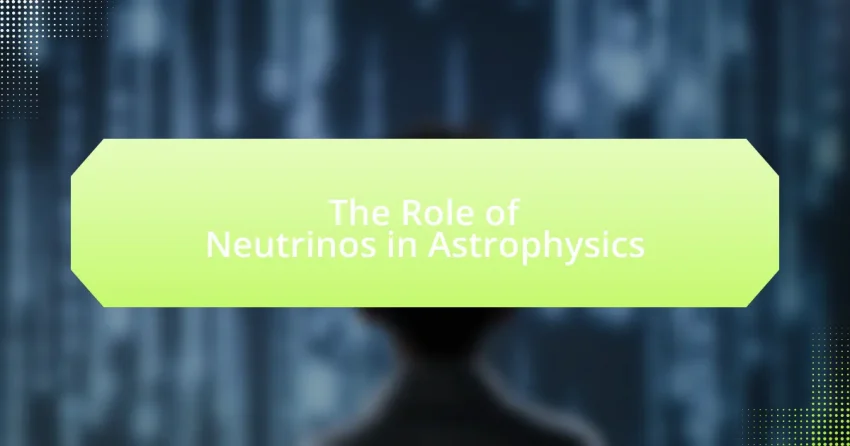Neutrinos are subatomic particles with negligible mass and no electric charge, produced in nuclear reactions such as those in the sun and during supernovae. Their weak interaction with matter allows them to provide critical insights into astrophysical processes that are otherwise difficult to observe, including solar fusion and core collapse mechanisms in stars. This article explores the unique properties of neutrinos, their role in cosmic events, the challenges of detecting them, and the advancements in detection methods. Additionally, it discusses the implications of neutrino research for fundamental physics and potential practical applications in energy solutions and medical imaging.

What are Neutrinos and Why are They Important in Astrophysics?
Neutrinos are subatomic particles with a very small mass and no electric charge, produced in nuclear reactions, such as those occurring in the sun and during supernova explosions. Their importance in astrophysics lies in their ability to provide insights into processes that are otherwise difficult to observe, as they interact very weakly with matter, allowing them to escape dense astrophysical environments. For instance, neutrinos emitted from the sun help scientists understand solar fusion processes, while those from supernovae can reveal information about the core collapse mechanisms. The detection of neutrinos from these cosmic events has been pivotal in confirming theoretical models of stellar evolution and the dynamics of the universe.
How do Neutrinos differ from other subatomic particles?
Neutrinos differ from other subatomic particles primarily due to their extremely small mass and neutral charge, which allows them to interact very weakly with matter. Unlike protons and electrons, which have significant mass and charge, neutrinos can pass through ordinary matter almost undetected; for instance, trillions of neutrinos from the Sun pass through your body every second without any interaction. This weak interaction is a defining characteristic, making neutrinos crucial in astrophysical processes such as supernovae and the fusion reactions in stars, where they carry away energy and information about these events.
What are the unique properties of Neutrinos?
Neutrinos are unique subatomic particles characterized by their extremely small mass, neutral charge, and weak interaction with matter. These properties allow neutrinos to pass through ordinary matter with minimal interaction, making them difficult to detect. For instance, trillions of neutrinos from the Sun pass through the Earth every second without any noticeable effect. Additionally, neutrinos exhibit a phenomenon known as oscillation, where they can change from one type (or flavor) to another as they travel, which has been confirmed by experiments such as those conducted by the Super-Kamiokande collaboration. This oscillation implies that neutrinos have mass, a discovery that has significant implications for particle physics and cosmology.
Why are Neutrinos difficult to detect?
Neutrinos are difficult to detect because they interact very weakly with matter. This weak interaction means that neutrinos can pass through entire planets without being absorbed or deflected, making them elusive to detection methods. For instance, billions of neutrinos from the Sun pass through a human body every second without any interaction. The detection of neutrinos typically requires large, sensitive detectors, such as those used in the Super-Kamiokande experiment in Japan, which employs over 50,000 tons of water to capture the rare interactions of neutrinos with other particles.
What role do Neutrinos play in cosmic events?
Neutrinos play a crucial role in cosmic events by serving as key indicators of high-energy processes in the universe, such as supernovae and gamma-ray bursts. These nearly massless particles are produced in vast quantities during these explosive events, allowing scientists to study the mechanisms behind them. For instance, the detection of neutrinos from the 1987 supernova in the Large Magellanic Cloud provided direct evidence of the core-collapse mechanism, confirming theoretical models of stellar evolution. Additionally, neutrinos can escape dense astrophysical environments, offering a unique glimpse into processes that are otherwise obscured by electromagnetic radiation. This ability to traverse matter without significant interaction makes neutrinos invaluable for understanding the dynamics of cosmic phenomena.
How are Neutrinos produced in stellar processes?
Neutrinos are produced in stellar processes primarily through nuclear fusion reactions in stars. During these reactions, such as the proton-proton chain and the CNO cycle, hydrogen nuclei fuse to form helium, releasing energy and generating neutrinos as byproducts. For instance, in the proton-proton chain, two protons fuse to create deuterium, releasing a positron and a neutrino. This process is fundamental in stars like the Sun, where approximately 99% of the energy output comes from such fusion reactions, resulting in the emission of vast numbers of neutrinos, estimated at around 65 billion neutrinos per second per square centimeter at Earth.
What is the significance of Neutrinos in supernovae?
Neutrinos play a crucial role in supernovae as they are the primary carriers of energy during the explosion. When a massive star undergoes gravitational collapse, it produces an enormous number of neutrinos, which escape the star’s core and carry away about 99% of the energy released in the supernova event. This energy loss is essential for the dynamics of the explosion, allowing the outer layers of the star to be expelled into space. The detection of neutrinos from supernovae, such as the 1987A event, provided direct evidence of their significance, confirming theoretical models of stellar collapse and explosion mechanisms.
How do Neutrinos contribute to our understanding of the universe?
Neutrinos contribute to our understanding of the universe by providing insights into fundamental processes such as nuclear reactions in stars and supernovae. These nearly massless particles interact very weakly with matter, allowing them to escape dense astrophysical environments and carry information about their origins. For instance, the detection of neutrinos from the 1987 supernova SN 1987A confirmed theories about stellar evolution and the mechanisms of supernova explosions. Additionally, neutrinos help in studying cosmic events, such as the interactions occurring in the Sun’s core, which can be observed through solar neutrino experiments like the Sudbury Neutrino Observatory. This ability to probe otherwise inaccessible regions of the universe enhances our knowledge of cosmic phenomena and the fundamental laws of physics.
What insights do Neutrinos provide about the early universe?
Neutrinos provide critical insights into the early universe by revealing information about the conditions and processes that occurred shortly after the Big Bang. These subatomic particles, which interact weakly with matter, can escape dense environments, allowing them to carry unaltered information from the early universe to present-day detectors. For instance, the detection of cosmic neutrinos from the Big Bang nucleosynthesis supports the theory of how light elements like hydrogen, helium, and lithium were formed in the first few minutes after the Big Bang. Additionally, neutrinos produced in supernovae events help scientists understand stellar evolution and the dynamics of the early universe, as they provide evidence of the processes that led to the formation of galaxies and large-scale structures.
How do Neutrinos help in studying black holes and neutron stars?
Neutrinos help in studying black holes and neutron stars by providing unique insights into the extreme environments surrounding these celestial objects. When neutron stars undergo supernova explosions or when matter falls into black holes, they emit vast quantities of neutrinos, which can escape the dense matter that light cannot. For instance, the detection of neutrinos from the 1987 supernova event (SN 1987A) allowed scientists to confirm theories about stellar collapse and the formation of neutron stars. This event produced a measurable flux of neutrinos, demonstrating their ability to convey information about processes occurring in regions that are otherwise obscured from electromagnetic observations. Thus, neutrinos serve as a crucial tool for understanding the physical conditions and dynamics associated with black holes and neutron stars.

What are the Current Methods for Detecting Neutrinos?
Current methods for detecting neutrinos include water Cherenkov detectors, liquid scintillator detectors, and gas Cherenkov detectors. Water Cherenkov detectors, such as the Super-Kamiokande in Japan, utilize large volumes of water to detect the faint light produced when neutrinos interact with water molecules. Liquid scintillator detectors, like the Borexino experiment in Italy, use organic liquid to capture neutrino interactions, producing detectable flashes of light. Gas Cherenkov detectors, such as the IceCube Neutrino Observatory in Antarctica, employ a large array of sensors embedded in ice to detect Cherenkov radiation from charged particles produced by neutrino interactions. These methods have been validated through numerous experiments, demonstrating their effectiveness in neutrino detection and contributing to our understanding of astrophysical phenomena.
How do different detection techniques work?
Different detection techniques for neutrinos work primarily through three methods: Cherenkov radiation detection, scintillation detection, and radio detection. Cherenkov radiation detection involves observing the light emitted when a charged particle, produced by a neutrino interaction, travels faster than the speed of light in a medium, such as water or ice. Scintillation detection relies on materials that emit light when charged particles interact with them, allowing for the measurement of neutrino events. Radio detection captures the radio waves generated by charged particles moving through ice or other media, which can indicate neutrino interactions. Each technique has been validated through experiments, such as the Super-Kamiokande experiment for Cherenkov radiation and the IceCube Neutrino Observatory for radio detection, demonstrating their effectiveness in identifying neutrinos from cosmic sources.
What is the principle behind Cherenkov radiation detection?
Cherenkov radiation detection is based on the emission of light when a charged particle, such as an electron, travels through a dielectric medium at a speed greater than the speed of light in that medium. This phenomenon occurs because the particle polarizes the medium, leading to the release of photons as the polarization returns to equilibrium. The principle is utilized in various detectors, such as neutrino observatories, where the detection of Cherenkov light helps identify the presence and properties of neutrinos interacting with matter. The effectiveness of this detection method is evidenced by its application in large-scale experiments like the IceCube Neutrino Observatory, which uses Cherenkov radiation to observe high-energy neutrinos from astrophysical sources.
How do liquid scintillator detectors operate?
Liquid scintillator detectors operate by using a liquid scintillator material that emits light when charged particles, such as electrons or positrons, interact with it. The interaction of these particles with the scintillator causes excitation of the molecules, leading to the emission of photons as the molecules return to their ground state.
These emitted photons are then detected by photomultiplier tubes (PMTs) or other light sensors, which convert the light signals into electrical signals for further analysis. The efficiency of liquid scintillator detectors in detecting neutrinos is enhanced by their ability to capture the faint light produced during these interactions, making them valuable tools in neutrino astrophysics research.
What challenges do researchers face in Neutrino detection?
Researchers face significant challenges in neutrino detection primarily due to the elusive nature of neutrinos, which interact very weakly with matter. This weak interaction means that neutrinos can pass through large volumes of material without being detected, requiring researchers to use massive detectors, such as those found in deep underground laboratories or underwater, to increase the likelihood of interaction. For instance, the IceCube Neutrino Observatory, located at the South Pole, utilizes a cubic kilometer of ice to capture the rare interactions of neutrinos, highlighting the need for extensive and sensitive detection environments. Additionally, background noise from cosmic rays and other particles complicates the detection process, necessitating sophisticated filtering techniques to isolate neutrino signals. These factors collectively make neutrino detection a complex and resource-intensive endeavor in the field of astrophysics.
How does background noise affect Neutrino measurements?
Background noise significantly impacts neutrino measurements by introducing interference that can obscure the detection of neutrino signals. In neutrino experiments, such as those conducted in deep underground laboratories, background noise from cosmic rays and radioactive decay can produce signals that mimic or mask the faint interactions of neutrinos with matter. For instance, in the Super-Kamiokande experiment, researchers found that background noise from muons and other particles could lead to false positives in neutrino detection, complicating data interpretation. This necessitates advanced filtering techniques and careful calibration to distinguish genuine neutrino events from background noise, ensuring the accuracy of measurements and the reliability of astrophysical conclusions drawn from them.
What advancements are being made to improve detection methods?
Advancements in neutrino detection methods include the development of larger and more sensitive detectors, such as the IceCube Neutrino Observatory, which utilizes a cubic kilometer of ice to capture high-energy neutrinos. These detectors employ advanced photomultiplier tubes and digital signal processing to enhance sensitivity and reduce background noise. Additionally, new materials and technologies, like liquid argon and scintillator detectors, are being explored to improve the efficiency and accuracy of neutrino interactions. Research indicates that these innovations can significantly increase the detection rate of neutrinos from astrophysical sources, thereby enhancing our understanding of cosmic events.

What are the Future Prospects for Neutrino Research in Astrophysics?
The future prospects for neutrino research in astrophysics are promising, particularly in enhancing our understanding of cosmic events and fundamental physics. Advanced detectors, such as the IceCube Neutrino Observatory and the upcoming Hyper-Kamiokande, aim to capture high-energy neutrinos from supernovae and gamma-ray bursts, providing insights into these phenomena. Additionally, the study of neutrinos may reveal new physics beyond the Standard Model, as ongoing experiments like DUNE (Deep Underground Neutrino Experiment) seek to investigate neutrino oscillations and mass hierarchy. These advancements are expected to significantly contribute to our knowledge of the universe’s structure and the fundamental forces at play.
How might Neutrino studies evolve with new technologies?
Neutrino studies may evolve significantly with advancements in detector technology, computational methods, and data analysis techniques. Enhanced detectors, such as those utilizing liquid argon or advanced photodetectors, can improve sensitivity and resolution, allowing for the detection of lower-energy neutrinos and more precise measurements of neutrino properties. For instance, the Deep Underground Neutrino Experiment (DUNE) aims to utilize liquid argon technology to explore neutrino oscillations and mass hierarchy, which could lead to breakthroughs in understanding fundamental physics. Additionally, machine learning algorithms can optimize data processing and analysis, enabling researchers to handle the vast amounts of data generated by neutrino experiments more efficiently. These technological advancements will likely lead to new discoveries in neutrino physics and their role in astrophysical phenomena, such as supernovae and cosmic ray interactions.
What role will large-scale observatories play in future research?
Large-scale observatories will play a crucial role in future research by enabling the detection and study of neutrinos, which are fundamental particles that provide insights into astrophysical processes. These observatories, such as the IceCube Neutrino Observatory, are designed to capture high-energy neutrinos from cosmic events, allowing scientists to investigate phenomena like supernovae, gamma-ray bursts, and black hole interactions. The data collected from these observatories will enhance our understanding of the universe’s most energetic processes and contribute to the development of new theories in astrophysics, as evidenced by IceCube’s discovery of a high-energy neutrino originating from a distant blazar, which confirmed the connection between cosmic rays and their sources.
How can artificial intelligence enhance Neutrino data analysis?
Artificial intelligence can enhance neutrino data analysis by improving the accuracy and efficiency of data interpretation. Machine learning algorithms can process vast amounts of data generated by neutrino detectors, identifying patterns and anomalies that traditional methods may overlook. For instance, deep learning techniques have been successfully applied to classify neutrino events, leading to a more precise understanding of neutrino properties and interactions. Research has shown that AI can reduce the time required for data analysis from weeks to hours, significantly accelerating scientific discoveries in astrophysics related to neutrinos.
What practical applications could arise from Neutrino research?
Neutrino research could lead to practical applications in fields such as medical imaging, nuclear security, and astrophysics. For instance, advancements in neutrino detection technology can enhance imaging techniques like positron emission tomography (PET), improving cancer diagnosis and treatment. Additionally, neutrinos can be utilized to monitor nuclear reactors and detect illicit nuclear activities, thereby contributing to global security efforts. Furthermore, understanding neutrinos can provide insights into fundamental astrophysical processes, potentially leading to new technologies in energy generation and particle physics. These applications are supported by ongoing research and developments in neutrino observatories and detection methods, which continue to evolve and expand their practical uses.
How might Neutrinos contribute to energy solutions?
Neutrinos might contribute to energy solutions by enabling advanced nuclear fusion processes, which could lead to cleaner and more efficient energy production. Research indicates that neutrinos are produced in vast quantities during nuclear reactions, such as those occurring in stars, and understanding their properties could help scientists replicate these processes on Earth. For instance, experiments like the ITER project aim to harness fusion energy, which relies on the same principles that govern stellar energy production, where neutrinos play a crucial role in energy balance and reaction rates. By studying neutrinos, researchers can gain insights into optimizing fusion reactions, potentially leading to sustainable energy sources that could significantly reduce reliance on fossil fuels.
What implications do Neutrinos have for fundamental physics?
Neutrinos have significant implications for fundamental physics, particularly in understanding the Standard Model and beyond. Their properties, such as mass and oscillation, challenge existing theories, suggesting that the Standard Model may be incomplete. For instance, the discovery of neutrino oscillation, evidenced by experiments like Super-Kamiokande, indicates that neutrinos have mass, which contradicts the original formulation of the Standard Model that assumed massless neutrinos. This finding necessitates new physics, potentially involving concepts like supersymmetry or extra dimensions, to explain the observed phenomena. Additionally, neutrinos play a crucial role in processes such as supernova explosions and the formation of the universe, influencing our understanding of cosmic evolution and the fundamental forces at play.
What are the best practices for engaging with Neutrino research?
The best practices for engaging with neutrino research include collaboration with interdisciplinary teams, utilizing advanced detection technologies, and staying updated with current literature. Collaboration enhances the research quality by integrating diverse expertise, as seen in projects like the IceCube Neutrino Observatory, which combines physics, engineering, and computer science. Employing advanced detection technologies, such as liquid argon time projection chambers, improves the sensitivity and accuracy of neutrino measurements, evidenced by the success of the DUNE experiment. Regularly reviewing current literature, including publications from journals like Physical Review D, ensures researchers remain informed about the latest findings and methodologies in the field.
